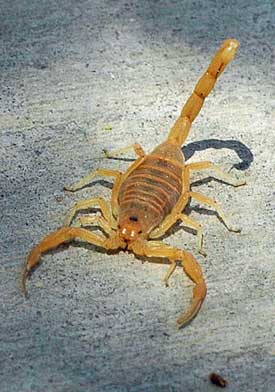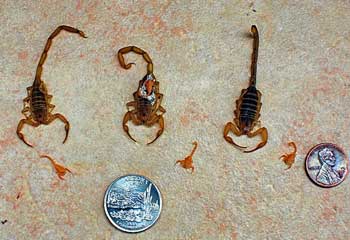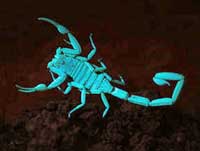BY MIA DITSON | AUGUST 17, 2011

Bark Scorpions
Nothing to mess with
 The word to describe bark scorpions (Centruroides sculpturatus) is “slender.”
The word to describe bark scorpions (Centruroides sculpturatus) is “slender.”
Their body (averaging 2 ½ in. total) is slender, the tail segments are long and slender. They have a fragile quality unlike the Giant Desert scorpion (Hadrurus arizonensis), and are uniformly tan. They are good climbers so will inhabit branches of trees and shrubs (hence the name), prey on smaller insects and are nocturnal. Their venom is highly concentrated and can be dangerous for some people.
A few months ago I had the extremely unpleasant experience of being stung by one. I was cleaning a storage room at Southwest Wildlife Rehabilitation Center and picked up a carry-on type bag. When it brushed my leg I initially felt something similar to the little fuzzies of prickly pear on my knee. For a few seconds there was no other sensation, but suddenly a fiery pain hit that spot. I thought “spider bite” and searched, but never saw any kind of critter. By now it felt as though someone had stabbed my leg with a red-hot poker and my leg just didn’t want to function.
I limped to the phone and called Poison Control. The volunteer asked me to describe the symptoms (nothing more than a tiny red dot) and the bite area. She told me the symptoms were indicative of a bark scorpion sting.
I was told to put ice on the site, if the pain got worse to take some Advil and if any swelling or breathing problems developed to take Benadryl, but not until such symptoms occurred. Also to call my doctor if further pain or problems developed. I wrapped an ice pack on my knee and headed home.
By now I was NOT in a good mood. The pain was incredible. After I’d driven about two miles I really wondered if I was going to make it home. I called a friend on my mobile and told him the route I was driving because I was beginning to feel “out of it” (also one of the possible symptoms). The pain was now god-awful and shooting in both directions up and down my leg. Once home I called my doctor. She basically told me the same thing Poison Control had, but told me to take the Benadryl immediately.
 Since Benadryl puts me to sleep for 14 hours and I didn’t want to zap what was left of my day, I didn’t take any. I took some Advil, applied more ice and lay down. In spite of the pain, I did fall asleep for awhile and woke up with no pain at all! “Hey,” I thought. “It’s over!” For about an hour things were great. Suddenly, with no warning, the fiery pain hit again worse than before, now with the addition of muscle cramps. The doctor’s office now closed, I called Poison Control again who suggested going to an emergency clinic. Instead, I called everyone I knew to see if they had any ideas.
Since Benadryl puts me to sleep for 14 hours and I didn’t want to zap what was left of my day, I didn’t take any. I took some Advil, applied more ice and lay down. In spite of the pain, I did fall asleep for awhile and woke up with no pain at all! “Hey,” I thought. “It’s over!” For about an hour things were great. Suddenly, with no warning, the fiery pain hit again worse than before, now with the addition of muscle cramps. The doctor’s office now closed, I called Poison Control again who suggested going to an emergency clinic. Instead, I called everyone I knew to see if they had any ideas.
Suggestions included aloe vera, baking soda paste, Epsom salt soak and crushed aspirin paste. Nothing worked. Neither did a search through all the books on bites and stings at the library. Doubling up on the Advil wasn’t helping. Finally, someone suggested Listerine soaked cotton. It did seem to numb things a bit. I took Benadryl and went to bed. Even though I was asleep I could tell I was in a lot of pain. There was no way of getting comfortable and it was a thoroughly restless night.
By noon the next day the pain was inescapable. In desperation I called another friend to see if she knew of any herbal remedies. She read me the section on bark scorpion stings from the book, Natural Remedies for Bites and Stings, by Peter Bigfoot with Angelique Zelle. His description of the symptoms was exactly what I had been going through.
Of his remedies I decided to try prickly pear pulp. The instant I put it on the pain disappeared! When that dried out the pain started again but with less intensity, so I applied more. After about 24 hours of this the pain subsided to a tolerable level.
 After a few days the pain was duller, but I had to frequently reapply the prickly pear pulp because the pain would “stab” again. I went through a period of numbness in my whole leg. I don’t remember how many days the symptoms actually lasted. After the worst was over that area of my knee felt bruised and extremely sensitive to touch. The actual bite site never showed any other evidence than a tiny red dot.
After a few days the pain was duller, but I had to frequently reapply the prickly pear pulp because the pain would “stab” again. I went through a period of numbness in my whole leg. I don’t remember how many days the symptoms actually lasted. After the worst was over that area of my knee felt bruised and extremely sensitive to touch. The actual bite site never showed any other evidence than a tiny red dot.
Getting stung in a more fleshy area of my body had been in my favor. Getting stung on a hand or foot allows the venom to enter the blood stream faster, possibly causing real problems. Fortunately, other than the pain, I did not have other reactions some people may be prone to.
I’ve been stung by the Giant scorpion and even though it hurts, usually 15 or 20 minutes of ice is all that’s needed. Until this experience, I’d never considered bark scorpions a big deal. But they are nothing to mess around with.
(Peter Bigfoot and Angelique Zelle are directors of the Reevis Mountain School and Sanctuary near Roosevelt, Arizona. Their book can be ordered from: HC02 Box 1534, Roosevelt, AZ 85545; phone: 520-467-2576.)
(The Desert Awareness Committee points out that this is the experience of one individual. People’s reactions to stings by desert critters and various types of treatments vary widely, and everyone must make his/her own decision about recommended remedies.)
AUGUST 17, 2011
Stop, drop and roll may not extinguish clothing that catches fire
Quincy, Mass. – The National Fire Protection Association (NFPA) is urging the public to employ extreme caution when using gel fuel, a product typically used with fire pots, personal fireplaces, and some patio torches. Stop, drop and roll may not extinguish clothing that catches fire involving splattered or spilled gel fuel. A dry chemical extinguisher or baking soda is recommended to extinguish the fire.
“As with any product, manufacturer’s instructions should be followed, but NFPA is issuing a special alert because we are seeing a number of cases where people have been injured while using gel fuel and are seemingly unaware of the dangers associated with its use,” said Lorraine Carli, NFPA’s vice president of communications.
NFPA Vice President Lorraine Carli discusses gel fuel safety:
Why is NFPA issuing this warning?
What are the dangers of using gel fuel?
Safety tips when using gel fuel
Recent news reports from across the country have highlighted several incidents where people have been injured while using gel fuel. A number of these injuries have occurred during the refueling process. NFPA warns the public that a flame may still be burning even when it is not visible, which is not uncommon with some gel fuel, and pouring fuel on any open flame is extremely unsafe. According to NFPA, it is also important to allow a gel fuel device to cool completely (30-45 minutes) before refueling because if the fuel comes into contact with the hot device it may splatter on clothing or skin, resulting in a burn injury.
“Anytime you are using devices that involve fire, it is critical to use caution and follow safety tips. This is proving to be especially important with gel fuel,” said Carli.
NFPA offers the following safety tips when using devices that gel fuel:
• Keep your face away from the device when refueling.
• If gel fuel is spilled on clothing, remove the clothing and launder it immediately.
• Never leave a lit fire pot, personal fireplace or patio torch unattended.
• Keep these devices at least one foot from anything that can burn.
• Place the fire pot or personal fireplace on a sturdy surface.
• Make sure patio torches are secure and not in the path of people or pets.
• Keep children and pets at least 3 feet away.
• These devices will be hot during and after burning; do not touch or move.
• Be careful reaching over the device because clothing or hair could catch fire.
• Use only gel fuel to refuel. Never substitute another kind of fuel.
• Citronella gel fuel is intended for outdoor use only.
• Allow the device to cool for 30–45 minutes before refueling.
• Pouring gel fuel in a device that is not completely cool may result in a fire or injury.
• Store the gel fuel in its tightly sealed original container; away from heat sources and out of reach of children and pets.
About the National Fire Protection Association (NFPA)
NFPA is a worldwide leader in fire, electrical, building, and life safety. The mission of the international nonprofit organization founded in 1896 is to reduce the worldwide burden of fire and other hazards on the quality of life by providing and advocating consensus codes and standards, research, training, and education. Visit NFPA’s website at http://www.nfpa.org for more information.



